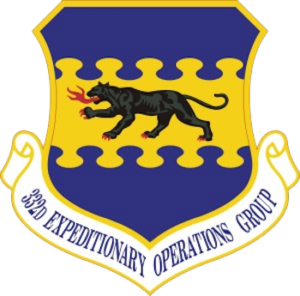
32d Fighter Group emblem
*The 332d Fighter Group was activated on this date in 1942. The 332d is a provisional air expeditionary group of the United States Air Force's Air Combat Command.
This Fighter Group was predominantly staffed by Black personnel and was home to the Tuskegee Airmen. The United States entered World War II with a military that was racially segregated and remained segregated until 1948. War Department planners generally placed White and Black Army personnel in separate units. Thus, the 332d Expeditionary Operations Group was established on July 4, 1942. The 332d Fighter Group comprised the 100th, 301st, and 302d Fighter Squadrons at Tuskegee Army Airfield, Alabama.
They were trained with Bell P-39 Airacobra and Curtiss P-40 Warhawk aircraft for an extended period because the Army Air Forces were reluctant to deploy Black fighter pilots for overseas combat. The 100th Fighter Squadron predates the 332d Fighter Group, formed on February 19, 1942. The 100th carried out advanced fighter training for graduates of the Tuskegee Institute, as well as primary and basic flight training programs for Black flight cadets at nearby Moton Field. The
first class (42-C) of twelve cadets and one student officer, Captain Benjamin O. Davis Jr., who served as Commandant of Cadets, began training on July 14, 1941. On March 6, 1942, this class graduated with Davis and five of the original twelve cadets, 2Lt. Lemuel R. Custis, 2Lt. Charles DeBow, 2Lt. George S. Roberts, and 2Lt. Mac Ross. "Spanky" Roberts was the first cadet to receive a diploma and wings during the ceremony. He went on throughout the time of combat operations of the 99th Fighter Squadron, and later, when that Squadron was assigned to the 332nd Fighter Group (which already consisted of three squadrons), to be the Deputy Commanding Officer, and at times when Colonel Davis was away, he served as the Group Commander.
The group's first combat assignment involved attacking enemy units on the strategic volcanic island in the Mediterranean Sea to clear the sea lanes for the Allied invasion of Sicily in July 1943. The air assault on the island began on May 30, 1943. The assignment to a predominantly ground attack role prevented the 99th from engaging in air-to-air combat.
In September 1943, Col. William W. Momyer criticized the unit for "(failure) to display...aggressiveness. Congressional hearings were held on this perceived failure, and neither the recommendation nor the hearings shut down the unit. This was because an AAF study reported that the 99th had performed as well as other P-40 units in the Mediterranean. In the meantime, the 99th received a Distinguished Unit Citation for its performance in combat on Sicily. Shortly after a Washington hearing on the feasibility of continuing to use African American pilots, three new fighter squadrons graduated from training at Tuskegee: the 100th, 301st, and 302nd. The units then embarked for Africa and were combined to form the all-Black 332d Fighter Group.
The squadrons were moved to mainland Italy. In January 1944, Luftwaffe Focke-Wulf Fw 190 fighter-bombers raided Anzio, where the Allies had conducted amphibious landings. Attached to the 79th Fighter Group, 11 of the 99th Fighter Squadron's pilots shot down enemy fighters. Captain Charles B. Hall claimed two shot down, bringing his aerial victory total to three. The eight fighter squadrons defending Anzio claimed 32 German aircraft shot down, while the 99th claimed the highest score with 13. In February, they began operations with the Twelfth Air Force to escort convoys, protect harbors, and fly armed reconnaissance missions. They converted to Republic P-47 Thunderbolts during April–May, and changed to P-51 Mustangs in June.
On May 1, 1944, the 99th Fighter Squadron assigned to the group joined them on the Adriatic coast. From there, the 332d Fighter Group escorted Fifteenth Air Force heavy strategic bombing raids into Czechoslovakia, Austria, Hungary, Poland, and Germany until April 1945. The 332d also flew escort missions in support of the repatriation of Americans from Romania and Yugoslavia to Italy. The Tuskegee Airmen initially were equipped with Curtiss P-40F and L model Warhawks (99th Squadron only), briefly with Bell P-39 Airacobras (March 1944), later with Republic P-47 Thunderbolts (June–July 1944), and finally with the aircraft with which they became most identified, the North American P-51 Mustang.
The unit received a Distinguished Unit Citation for a mission on March 24. During the action, its pilots destroyed three Me 262s of the Luftwaffe's examination of German records, JG 7 records, and just four Me 262s, which were lost, and all the pilots survived. Three of the four Me 262 jets that the Luftwaffe lost were shot down; all their pilots bailed out wounded. Flying escort for heavy bombers, the 332d earned an impressive combat record. Reportedly, the Luftwaffe awarded these airmen the nickname "Schwarze Vogelmenschen," or "Black Birdmen." The Allies called these airmen "Redtails" or "Redtail Angels" because of the distinctive crimson paint applied on the vertical stabilizers of the unit's aircraft.
With the end of European hostilities in May 1945, the 332d was reassigned to the 305th Bombardment Wing to prepare to move to the Pacific Theater and engage in combat against Japan. With the atomic bombings of Hiroshima and Nagasaki and the end of the war, this became unnecessary, and the 332d returned to the United States. It was assigned to Camp Kilmer, New Jersey, where it was inactivated in October 1945 and reactivated on November 16, 2014.